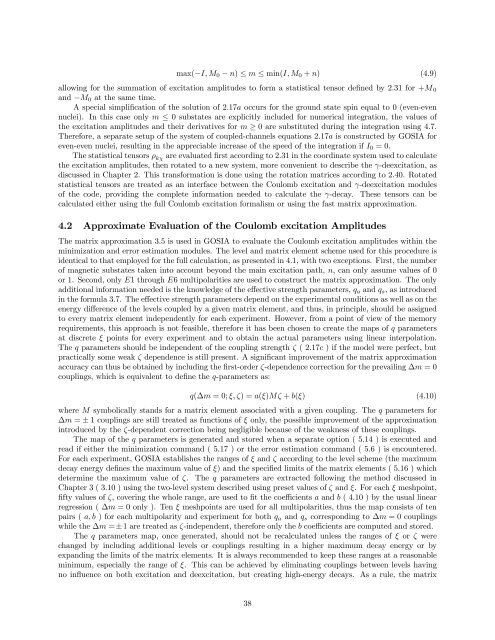coulomb excitation data analysis codes; gosia 2007 - Physics and ...
coulomb excitation data analysis codes; gosia 2007 - Physics and ...
coulomb excitation data analysis codes; gosia 2007 - Physics and ...
You also want an ePaper? Increase the reach of your titles
YUMPU automatically turns print PDFs into web optimized ePapers that Google loves.
max(−I,M 0 − n) ≤ m ≤ min(I,M 0 + n) (4.9)allowing for the summation of <strong>excitation</strong> amplitudes to form a statistical tensor defined by 2.31 for +M 0<strong>and</strong> −M 0 at the same time.A special simplification of the solution of 2.17a occurs for the ground state spin equal to 0 (even-evennuclei). In this case only m ≤ 0 substates are explicitly included for numerical integration, the values ofthe <strong>excitation</strong> amplitudes <strong>and</strong> their derivatives for m ≥ 0 are substituted during the integration using 4.7.Therefore, a separate setup of the system of coupled-channels equations 2.17a is constructed by GOSIA foreven-even nuclei, resulting in the appreciable increase of the speed of the integration if I 0 =0.The statistical tensors ρ kχ are evaluated first according to 2.31 inthecoordinatesystemusedtocalculatethe <strong>excitation</strong> amplitudes, then rotated to a new system, more convenient to describe the γ-de<strong>excitation</strong>, asdiscussed in Chapter 2. This transformation is done using the rotation matrices according to 2.40. Rotatedstatistical tensors are treated as an interface between the Coulomb <strong>excitation</strong> <strong>and</strong> γ-de<strong>excitation</strong> modulesof the code, providing the complete information needed to calculate the γ-decay. These tensors can becalculated either using the full Coulomb <strong>excitation</strong> formalism or using the fast matrix approximation.4.2 Approximate Evaluation of the Coulomb <strong>excitation</strong> AmplitudesThe matrix approximation 3.5 is used in GOSIA to evaluate the Coulomb <strong>excitation</strong> amplitudes within theminimization <strong>and</strong> error estimation modules. The level <strong>and</strong> matrix element scheme used for this procedure isidentical to that employed for the full calculation, as presented in 4.1, with two exceptions. First, the numberof magnetic substates taken into account beyond the main <strong>excitation</strong> path, n, can only assume values of 0or 1. Second, only E1 through E6 multipolarities are used to construct the matrix approximation. The onlyadditional information needed is the knowledge of the effective strength parameters, q a <strong>and</strong> q s , as introducedin the formula 3.7. Theeffective strength parameters depend on the experimental conditions as well as on theenergy difference of the levels coupled by a given matrix element, <strong>and</strong> thus, in principle, should be assignedto every matrix element independently for each experiment. However, from a point of view of the memoryrequirements, this approach is not feasible, therefore it has been chosen to create the maps of q parametersat discrete ξ points for every experiment <strong>and</strong> to obtain the actual parameters using linear interpolation.The q parameters should be independent of the coupling strength ζ ( 2.17c ) if the model were perfect, butpractically some weak ζ dependence is still present. A significant improvement of the matrix approximationaccuracy can thus be obtained by including the first-order ζ-dependence correction for the prevailing ∆m =0couplings, which is equivalent to define the q-parameters as:q(∆m =0;ξ,ζ) =a(ξ)Mζ + b(ξ) (4.10)where M symbolically st<strong>and</strong>s for a matrix element associated with a given coupling. The q parameters for∆m = ± 1 couplings are still treated as functions of ξ only, the possible improvement of the approximationintroduced by the ζ-dependent correction being negligible because of the weakness of these couplings.The map of the q parameters is generated <strong>and</strong> stored when a separate option ( 5.14 ) is executed <strong>and</strong>read if either the minimization comm<strong>and</strong> ( 5.17 ) or the error estimation comm<strong>and</strong> ( 5.6 ) is encountered.For each experiment, GOSIA establishes the ranges of ξ <strong>and</strong> ζ accordingtothelevelscheme(themaximumdecayenergydefines the maximum value of ξ) <strong>and</strong> the specified limits of the matrix elements ( 5.16 ) whichdetermine the maximum value of ζ. The q parameters are extracted following the method discussed inChapter 3 ( 3.10 ) using the two-level system described using preset values of ζ <strong>and</strong> ξ. Foreachξ meshpoint,fifty values of ζ, covering the whole range, are used to fit thecoefficients a <strong>and</strong> b ( 4.10 ) by the usual linearregression ( ∆m =0only ). Ten ξ meshpoints are used for all multipolarities, thus the map consists of tenpairs ( a, b ) for each multipolarity <strong>and</strong> experiment for both q a <strong>and</strong> q s corresponding to ∆m =0couplingswhile the ∆m = ± 1 are treated as ζ-independent, therefore only the b coefficients are computed <strong>and</strong> stored.The q parameters map, once generated, should not be recalculated unless the ranges of ξ or ζ werechanged by including additional levels or couplings resulting in a higher maximum decay energy or byexp<strong>and</strong>ing the limits of the matrix elements. It is always recommended to keep these ranges at a reasonableminimum, especially the range of ξ. This can be achieved by eliminating couplings between levels havingno influence on both <strong>excitation</strong> <strong>and</strong> de<strong>excitation</strong>, but creating high-energy decays. As a rule, the matrix38
















